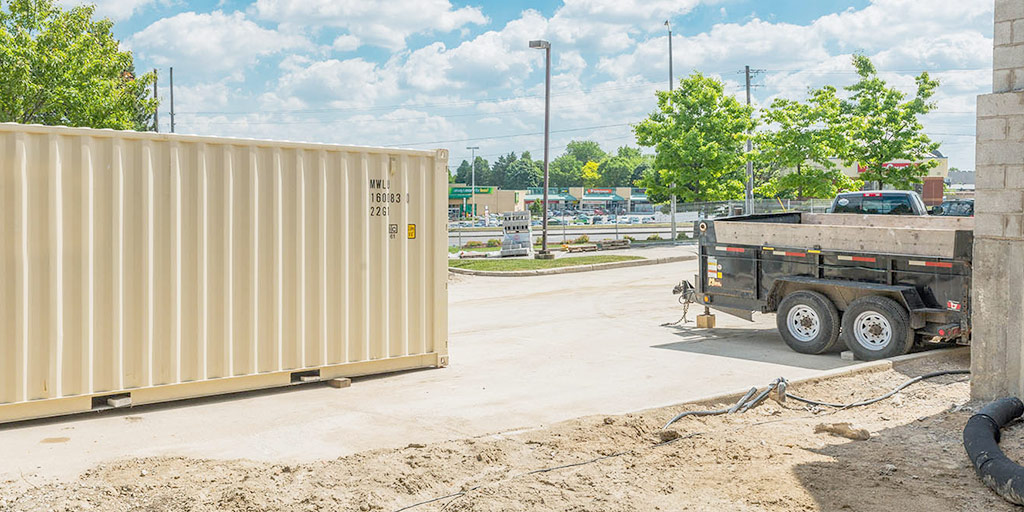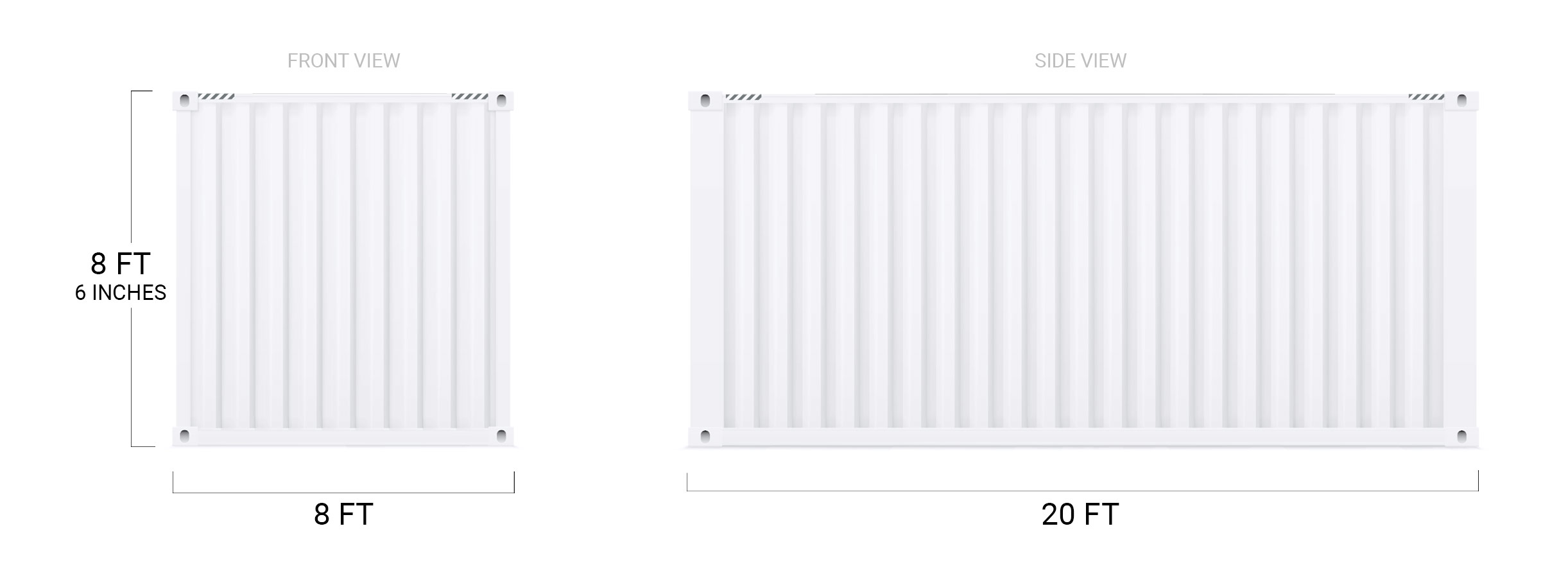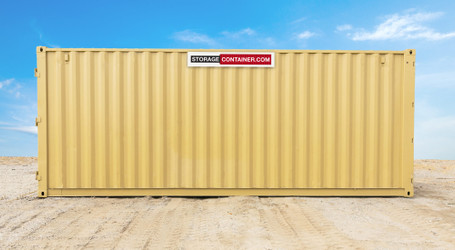Shipping Container Dimensions and Uses – Which is Right for You? | 20ft Containers
Mar 7th 2022
20ft Shipping Container
The 20 ft shipping container is one of the most frequently used shipping containers and is the smallest unit handled in most ports.
Creative Uses of 20ft Containers
The versatile 20 ft container has many uses from the transportation of goods to jobsite storage, but these versatile containers can be used for many other applications needing secure, weatherproof, and portable space, including:
| Temporary warehousing for excess stock | Disaster relief |
|---|---|

|

|
| Pop-up shops | Photography studios |
|---|---|

|

|
| Temporary rented storage | Permanent storage – replacement shed, etc. |
|---|---|

|

|
| Modular building unit | Office or retail space |
|---|---|

|

|
Dimensions
The external measurements of this shipping container size are:
•
Length – 20 feet.
•
Width – 8 feet.
•
Height – 8 feet 6 inches.

The interior dimensions are a little smaller:
•
Length – 19 feet 4 inches
•
Width – 7 feet 9 inches
•
Height – 7 feet 10 inches

Volume
The capacity or internal volume of this storage container size is approximately 1,156 cubic feet. Adding shelving and leaving space to walk in and access the shelves reduces the storage capacity to 405 cubic feet. The internal floor area is approximately 146 square feet.
Weight
In the US, legal shipping container weight for transport depends on how you intend to move the 20 ft storage container:
•
Tri-axle Truck Chassis - 44,000 lbs
•
Slider Chassis – 39,200 lbs
•
Rail – 52,900 lbs
•
Maximum cargo weight – 67,200 lbs
The storage container weight (when empty) is 4,800lbs. It is crucial when planning to use mixed transport (rail followed by road) that you keep within the lowest weight limits when packing your container.
What Can Fit Inside?
You can fit a surprisingly large amount in a 20 ft container, but you need to leave space to be able to pack and unpack your container for long-term storage. If you are using it for transport, you can pack quite densely. To get an idea of how much you can fit inside a 20 ft storage container:
• 10 standard loaded American pallets (40" X 48")
• 100 washing machines
• Between 50 and 60 fridges
• A family car plus some furniture
• 23 wardrobes
• 4,000 shoeboxes
• 9,600 bottles of wine
• 168 NASCAR tires
If you are planning a house move or doing some remodeling, a 20ft shipping container holds a lot of furniture with room to spare. You can fit furniture from three to six rooms inside this container size, so you have enough space to move the contents of an average house. If you want a spacious garden shed, the 20 ft shipping container dimensions allow for storage for all your tools, and you’ll still have room for your ride-on mower.
The storage container dimensions accommodate most kayaks – the precise number will depend on how you want to fit out the container to provide optimal storage for drying and security. This container size is also excellent for storing a whole team's worth of sporting equipment with room to spare for most sports.
Benefits of a 20ft Container
Why choose a 20 ft container for your project?
• You get plenty of storage space for most purposes.
• This container size makes a spacious office for one, with storage.
• More affordable than a larger 40-foot container.
• Ideal for transporting or storing household furniture and appliances.
• Adaptable for storing cars, motorbikes, and other equipment.
• Flexible storage for job sites – doesn't occupy an excessive amount of space.
• Straightforward to deliver for most business and domestic uses.
• Portable and suitable for remote locations.
• Ideal modular building unit.
The 20 ft container is straightforward to deliver to most sites and is one of the most popular for nearly all purposes.
What Do You Need to Know Before Getting a Quote?
The simple questions you need to know before you ask for a quote are:
• Is it best to rent or buy?
• Is it the right size?
• Where can you put it?
Rent or Buy?
Before you can consider buying a storage container, you need to have enough space to store it on your property. You may own the land, but your local and state regulations may restrict what you can put on your property.
Buying may be the best option if you want to modify the container to turn it into a non-standard office, guest room, or workshop. If you need permanent storage for your stuff, purchasing is likely to be the best option in the long run.
Renting is a better option if you need to use short-term storage – on a jobsite, you may want different storage containers for various sites, and there may be times when you don't need a container. Renting what you need when you need it is more affordable than paying for storage and transport of a shipping container when not in use.
If you cannot store a 20 ft storage container at your premises, you can rent a storage container off-site. Renting is the better option for some homes and businesses if you need:
• Short-term flexible access.
• Portability with transport provided.
• Portability with transport provided.
• Standard storage or office space.
Is It the Right Size?
You can do a lot with 146 ft² floor space. An executive office needs between 90 and 150ft², which means a 20 ft shipping container provides a comfortable office for most purposes.
Provided the objects you want to store fit inside the internal storage container dimensions, with enough space for necessary access, this shipping container size will suit your needs. Rather than a straight box, you may want to add shelving and custom racks. Tool storage is better if you can walk in and see the tools on display. If you are moving houses or delivering goods to a warehouse, the way you pack the container is different from using it for storing sports equipment that you need to use every week.
It can be challenging to visualize how stuff fits inside a shipping container without practice, but if it helps, think about the average six-foot person – three can lie along the length, and one can lie across the width.
Do You Have Enough Space?
When working out how much space you need to store your shipping container, remember to have access for the truck that will deliver and offload it. You need an area with level ground that matches the dimensions of the 20 ft shipping container with enough space to allow access to the doors for loading and unloading.
For a 20 ft container, you generally need:
• 75 ft straight clearance to get the container in place.
• 12 ft width clearance.
• 20 ft overhead clearance.

Get A Quote Today

